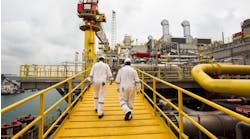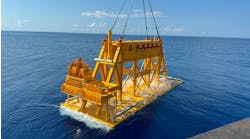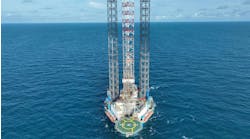Offshore staff
HOUSTON – During the recent Offshore Technology Conference, ABS officials discussed technology related to several issues of key industry focus: high-pressure/high-temperature (HP/HT); aging jackups, which the organization said comprises more than 50% of the global fleet; advanced inspection techniques; the importance of computational fluid dynamics as the industry increases its efforts for energy efficiency; and advanced inspection technologies, including helmet cameras and drones.
In addition, Cris DeWitt, ABS’ senior manager - Operational Technologies, spoke on the industry’s movement towardautomation and the increasingly complex software and systems that accompanied this shift. As a result, cybersecurity and system vulnerabilities are also becoming an amplified threat, as incidents related to these areas could result in unexpected consequences.
Cybersecurity and software integrity management are both increasingly vital to understanding the industries’ systems, software, and its overall system safety, DeWitt said.
One way that the company is addressing these issues is with CyberSafety guidance, released in February, he explained, noting that it is the industries’ first risk-based management program for asset owners to apply best practice approaches to four key cyber areas: cybersecurity, cyber systems test, data management, and software assurance.
ABS published Guidance Notes that provide best practices for cybersecurity as a foundational element of overall safety and security within and across the marine and offshore industries. It is also developing a cybersecurity guide and is developing a cybersecurity joint development project to verify and validate actionable policies and procedures on offshore drilling units.
Another issue addressed was advanced inspection techniques and its work in determining the ways that changes brought about by its related technology – including so-called “smart assets,” and automated machinery and equipment, among others – might impact safety.
The classification society is moving toward methodology it calls FutureClass, meaning that its approach to surveys and inspections will be characterized as more condition-based, continuous, and risk-driven. Instead of following a calendar-based inspection and survey schedule, James Bond, ABS project management director, explained, the company will rely more on performance data. To do this, the organization is working to incorporate technology like hardhat cameras, unmanned aerial vehicles, and hovering autonomous underwater vehicles to its offerings.
Jim Brekke, who oversees theABS jackup focus group, spoke on its involvement with aging jackups. Recently, the industry has turned its attention to damage suffered during jackup moves, including the related safety and cost implications. In addition to working with jackup owners on hull and equipment inspections and monitoring, ABS is writing industry standards on rig moves, which will be complemented by guidance notes to develop simplified methods for determining operational limits. It is also developing changes to its existing rules to accommodate leg foundation fixity.
In light of the current market, ABS has also issued guidance on laying up jackups that are moving out of service so they can be reactivated expediently when the market turns and demand goes back up.
Also discussed was the work the classification society is doing on HP/HT equipment qualification. The focus has been on developing technology qualification (TQ) guidance to increase understanding of system parameters, behavior, and risks for HP/HT equipment, as the current limitations of 15,000 psi (1,034 bar) and 250°F (121°C) will be insufficient for new discoveries.
In discussing this topic, ABS Senior Advisor Harish Patel said the company is working with all three major BOP manufacturers, several major operators, and drilling contractors in systematic TQ for HP/HT equipment and pressure-control equipment. The classification society also works with regulators including the US Bureau of Safety and Environmental Enforcement on regulatory requirements and participates in all major codes and standards committee to help develop proper standards such as API, ASME, etc.
05/09/2016


